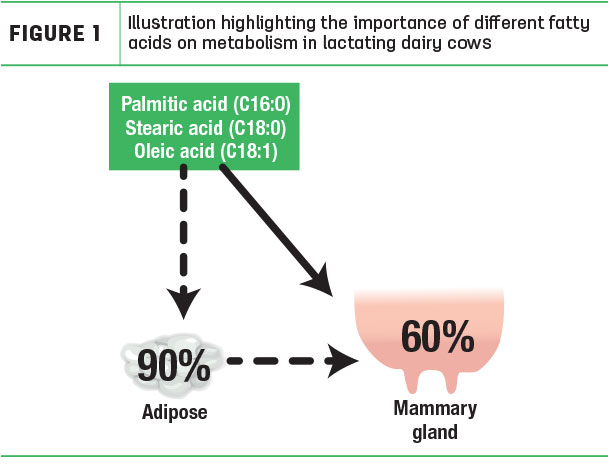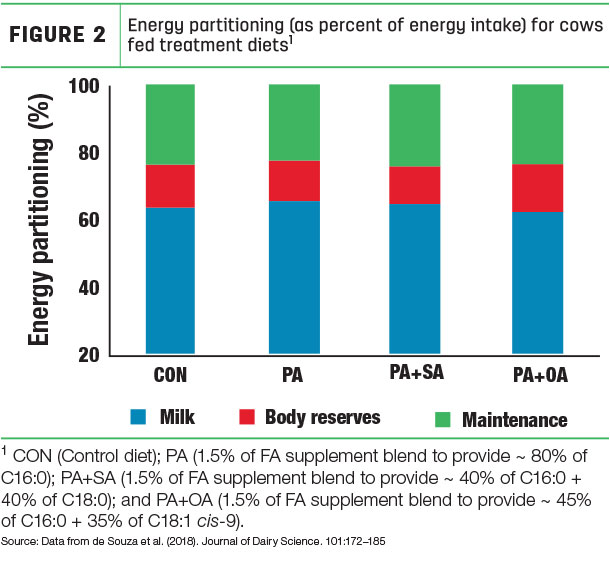Fat and fatty acid (FA) digestion and metabolism in dairy cattle is of considerable interest to the dairy industry. The subject has received renewed interest for a number of reasons. First, the addition of supplemental FA sources to diets is a common practice in dairy nutrition to increase dietary energy density and to support milk production.
Second, we now recognize FAs can have specific and potent effects on ruminant digestion and metabolism. Although, in general, FA supplementation has been shown to increase milk yield, milkfat yield and the efficiency of milk production, great variation has been reported in production performance for different FA supplements and, indeed, the same supplement across different diets and studies.
There is a wide range of FA supplements available for lactating dairy cattle. Although these supplements may vary in the method of protection, particle size and degree of esterification, the profile of supplemental fat is most likely the major factor affecting production responses.
Recent research has focused on specific FAs and how dairy cows respond differently to combinations of FAs across different stages of lactation. Much focus has been on the effects of dietary palmitic (C16:0), stearic (C18:0) and oleic (cis-9 C18:1) acids because these FAs comprise the major FAs in a wide range of commercially available fat supplements, and they represent a large proportion of FAs in milkfat and adipose tissue (Figure 1).

The impact of altering the FA profile of supplemental fat in dairy cow rations is highlighted in our recent studies. By changing the profile of the FA supplied in the supplement, we can observe differences in nutrient digestibility, milk and milkfat yield, and bodyweight gain.
In a recent study, we compared combinations of C16:0, C18:0 and cis-9 C18:1 in an FA supplement (fed at 1.5 percent of diet dry matter) to post-peak cows. A supplement containing more C16:0 (80 percent C16:0 and 10 percent cis-9 C18:1) increased milk yield and milkfat yield response more when compared with other treatments.
In contrast, an FA supplement containing C16:0 and cis-9 C18:1 (45 percent C16:0 and 35 percent cis-9 C18:1) increased bodyweight and body condition scores when compared to other treatments. The FA supplement containing a combination of C16:0 and C18:0 (40 percent C16:0 and 40 percent C18:0) reduced nutrient digestibility, which most likely explains the lower production responses observed compared with the other treatments.
This may suggest C16:0 and cis-9 C18:1 are able to alter energy partitioning to milk or body reserves, which may allow for different FA supplements to be fed in specific situations according to the metabolic priority and needs of dairy cows (Figure 2).

In a follow-up study, we changed the ratio of C16:0 and cis-9 C18:1 of an FA supplement and fed these two different groups of post-peak cows according to their production level. The FA supplement with more C16:0 (80 percent C16:0 and 10 percent cis-9 C18:1) increased milk production, milkfat and protein yields in cows producing less than 100 pounds per day, while supplements with more cis-9 C18:1 (60 percent C16:0 and 30 percent cis-9 C18:1) favored milk production responses in cows producing greater than 130 pounds per day.
Interestingly, regardless of production level, supplements with more cis-9 C18:1 increased bodyweight gain. These results highlighted different FA supplements or combinations of FAs should be used according to the production level of the herd or specific group of cows.
In fresh cows, the high metabolic demand of lactation during the immediate postpartum period results in a state of negative energy balance. Effects are contradictory about the benefits of FA supplementation to early lactation dairy cows. We suggest this is a result of differences in the FA profile of supplements used and the time at which FA supplementation starts.
In a recent study, we evaluated the effects of timing of C16:0 supplementation on performance of early lactation dairy cows. During the fresh period (one to 24 days after calving), we did not observe treatment differences for feed intake but, when compared with the control, C16:0 increased the yield of energy-corrected milk by 11 pounds per day consistently over time.
However, C16:0 reduced bodyweight by 46 pounds compared with the control. Feeding C16:0 during the peak period (25 to 67 days after calving) increased the yield of milk by 8 pounds per day, energy-corrected milk yield by 11 pounds per day and tended to reduce bodyweight by 22 pounds compared to the control group. In a follow-up study with fresh cows, we changed the ratio of C16:0 and cis-9 C18:1 of the FA supplement to fresh cows (one to 24 days after calving).
Similar to our previous study, a recent study feeding a FA supplement with more C16:0 (80 percent C16:0 and 10 percent cis-9 C18:1) increased milk yield by 5 pounds per day, energy-corrected milk yield by 11 pounds per day and tended to reduce bodyweight by 33 pounds when compared to the control.
On the other hand, feeding an FA supplement with more cis-9 C18:1 (60 percent C16:0 and 30 percent of cis-9 C18:1) increased milk yield by 5 pounds per day, energy-corrected milk yield by 10 pounds per day and did not impact bodyweight compared with the control. These results indicated fresh and early lactation cows responded favorably to supplemental fat and the effects on bodyweight were dependent upon the FA profile of the supplement.
In summary, our results emphasize it is key to know what FAs are present in the diet and especially in any fat supplements fed. Also, both palmitic and oleic acids are key FAs to consider when choosing a supplement.
When choosing an FA supplement, it is important to consider the possible effects of these FAs on feed intake, rumen metabolism, small intestine digestibility, milk component synthesis in the mammary gland, energy partitioning between the mammary gland and other tissues, body condition and their effects on immune and reproductive function.
The extent of these simultaneous changes will determine the overall effect of the FA supplementation and the associated decision regarding their inclusion in diets for lactating dairy cows. ![]()
References available from author upon request. Click here to email an editor.

-
Jonas de Souza
- Ph.D. Candidate - Department of Animal Science
- Michigan State University
- Email Jonas de Souza








